Featured Application
The proposed speech communication system can be used in mechanical antenna-based low-frequency communications.
Abstract
Low-frequency electromagnetic waves have strong penetration and low attenuation performance, making them widely used in long-wave communication areas such as underwater communication and earthquake prediction. Mechanical antennas are seen as a promising alternative to traditional low-frequency resonant antennas, as they offer the potential for miniaturization and low power consumption. However, existing communication systems using mechanical antennas are usually rudimentary, incompatible, and inconvenient to use. To address these problems, a novel speech communication system based on a piezoelectric electret mechanical antenna was proposed. This communication system includes a hardware system, a communication protocol for mechanical antennas, and a software system with a modular structure. This system includes hardware, a communication protocol, and a modular software system. The results of the experiments showed that this communication system provides real-time speech communication with a user-friendly design, high compatibility with different communication devices, and easy customization to meet specific requirements. This design holds great potential for applications in mineral detection, seismic research, submarine communication, industrial RF control, and other related mechanical antenna applications.
1. Introduction
In solid and liquid environments, high-frequency electromagnetic (EM) waves will rapidly attenuate due to the skin effect, making them more challenging to apply in wireless communication areas like underwater and underground communications [1,2,3,4]. With the advantages of strong penetration and low attenuation, low-frequency (LF, 30–300 kHz), very-low-frequency (VLF, 3–30 kHz), and ultra-low-frequency (ULF, 300–3000 Hz) EM waves have excellent propagation performance in solids and liquids and are widely used in underwater communication, earthquake prediction, and other applications [5,6,7,8]. However, the size of traditional resonant antennas is typically comparable to the wavelength of EM waves. When resonant antennas are used for long-wave communication, they inevitably grow to huge sizes beyond a hundred meters, facing problems such as high cost, high energy consumption, and a low power conversion rate [9,10,11].
Currently, mechanical antennas have become a research hotspot for LF, VLF, and ULF antennas. Mechanical antennas are appealing due to their ease of miniaturization, low cost, and simple impedance matching network for low-frequency communication. Mechanical antennas are driven by mechanical rotation or vibration, and they radiate EM waves via the movement of internal electric charges or magnetic dipoles [12,13]. Permanent magnet mechanical antennas and piezoelectric mechanical antennas are the two types of mechanical antennas. Permanent magnet antennas generate EM waves by driving permanent magnets with external motors [14,15,16]. Meanwhile, piezoelectric mechanical antennas generate self-resonance through the piezoelectric effect and oscillate their internal dipole moment, thus radiating EM waves [17,18,19].
Despite the potential benefits, current mechanical antenna-based communication systems still face significant challenges. As an emerging communication composite, existing systems of mechanical antennas are rudimentary and still in the starting phase without complete communication protocol design and software support. They are often developed independently for specific mechanical antennas or applications, leading to a high degree of coupling and poor system compatibility. In addition, the working methods of existing systems are inconvenient to use, and the operating procedures for these systems are often cumbersome, requiring specialized knowledge and even direct operation of underlying hardware devices for information transmission and reception [14,15,16,17,18,19].
To solve these challenges, a novel speech communication system based on the PZT-42 piezoelectric electret mechanical antenna is proposed. The working mechanism and performance of the PZT-42 mechanical antenna are briefly introduced, and the components of the speech communication system are well explained. This speech communication system is proposed with the following key contributions:
- A mechanical antenna communication hardware system is designed;
- A three layer hierarchical mechanical antenna communication protocol is proposed;
- A software system with an extensible modular architecture is proposed.
Additionally, the system proposed a human-computer interaction that provides speech input for messages to be transmitted in order to achieve a humanized design. As a supplement, a case study is conducted to demonstrate the overall workflow of the system and the specific responsibilities of each component. By integrating the system with mechanical antenna-based communication, data transmission and message processing are effectively decoupled, and compatibility and scalability are greatly enhanced.
2. Materials and Methods
2.1. Mechanism of the PZT-42 Mechanical Antenna
Lead zirconate titanate piezoelectric ceramic 42 (PZT-42) is a widely utilized piezoelectric ceramic material with a high dielectric constant [20,21]. Mechanical antennas made of PZT-42 have been shown to result in substantial enhancements in the radiation intensity of EM waves [17]. The piezoelectric ceramics will be stimulated to generate an inverse piezoelectric effect and produce elastic displacement when the external electric field is applied [22,23,24], as shown in Figure 1a. At the same time, the dipole moment inside the electret follows the material displacement and oscillates, thus radiating EM waves externally. The mechanical antenna, with dimensions of 30 × 15 × 3 mm3, is comprised of a PZT-42 piezoelectric ceramic substrate with silver electrodes on its upper and lower surfaces, serving as a mechanical antenna in speech communication systems. As illustrated in Figure 1b, the carrier signals amplified by the power amplifier are used as an AC source and fed to the mechanical antenna through the silver electrodes to stimulate the mechanical antenna for radiating EM waves in wireless communication [25]. As demonstrated in Figure 1c,d, the proposed mechanical antenna exhibits a resonant peak and a minimum impedance within the range of 165–170 kHz. At its resonant frequency of 167.34 kHz, the PZT antenna obtains maximum radiation intensity, proving that it is capable of radiating EM waves externally as an antenna. The signal strength of the permanent magnet mechanical antenna depends on the magnetic field strength of the permanent magnet, and the operating frequency and modulation frequency are limited by the performance of the external motor, which also limits the transmission distance and transmission speed of the permanent magnet mechanical antenna. While the signal strength of a piezoelectric mechanical antenna can be improved with an increase in feed voltage, the operating frequency can be modified by changing the material and size of the piezoelectric antenna, and the modulation frequency can be controlled by the carrier signal. Therefore, the operating frequency, transmission distance, and transmission speed of piezoelectric mechanical antennas are generally higher than those of permanent magnet mechanical antennas, which leads to better communication performance.
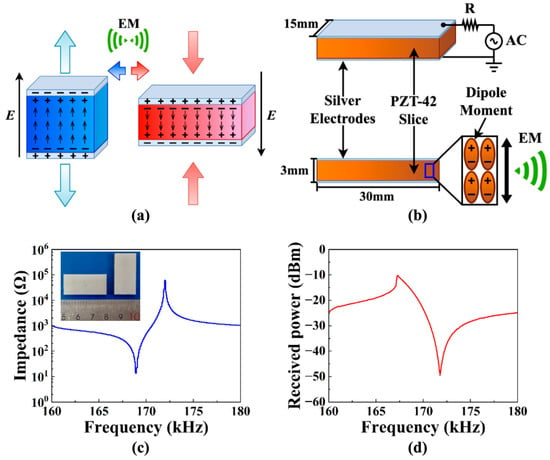
Figure 1.
Mechanism and performance of the PZT-42 mechanical antenna. (a) Simplified illustration of the working mechanism. (b) The PZT-42 resonator in 3D and from the side. (c) Impedance curve of the PZT-42 mechanical antenna in the range of 160–180 kHz. (d) Received wireless spectrum using the PZT-42 mechanical antenna in the range of 160–180 kHz.
The resonant frequency of piezoelectric mechanical antennas is usually dependent on the materials and dimensions of the antenna. Changing antennas with different piezoelectric materials and dimensions to tune the operating frequency can make the system apply to different applications [17]. Piezoelectric electret mechanical antennas could achieve resonant frequencies in the ULF, VLF, and LF bands with different piezoelectric materials and antenna size designs, allowing the proposed system to work in a variety of applications. The LF antennas can be used for real-time communication and RF control, the VLF antennas for underwater submarine communication, and the ULF antennas for mineral detection and seismic research.
2.2. Speech Communication System Design
Based on the PZT-42 piezoelectric electret mechanical antenna, a speech communication system is proposed for promoting the practical application of mechanical antennas. In this section, the specific design and implementation of the speech communication system will be described in terms of the hardware system, communication protocol, and software system.
2.2.1. Hardware System
The proposed hardware system architecture is shown in Figure 2. It encompasses a transmitter terminal, an arbitrary function generator (AFG), a power amplifier, a mechanical antenna, a receiving loop antenna, a lock-in amplifier (LIA), and a receiver terminal. The hardware system architecture is shown in Figure 2. The transmitter terminal consists of a computer equipped with a microphone and functions as the input processing device and the AFG control module. The signals are amplified by the power amplifier and fed directly to the PZT-42 mechanical antenna to stimulate it to radiate the signals. At the receiver side, the signals are received by an active loop antenna. The receiving device is an LIA with noise filtering function. Finally, the receiver terminal reads the signals and outputs the messages.

Figure 2.
Hardware system of the speech communication system. (a) Architecture design. (b) A real-time photo of the measurement environment.
2.2.2. Communication Protocol
The communication protocol refers to the OSI model [26] and adopts a layered design, dividing the mechanical antenna communication protocol into a user layer, a presentation layer, and a physical layer. The protocol stack is shown in Figure 3. The protocol stack is symmetrically organized on both the transmitter and receiver sides, with each layer offering services to its corresponding layer above and below.
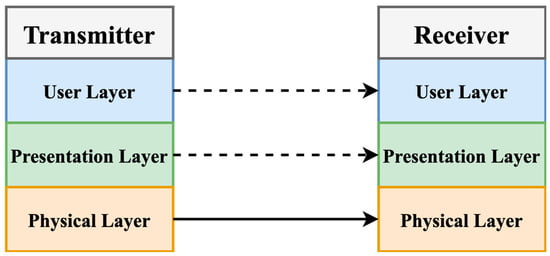
Figure 3.
Communication protocol stack.
The user layer processes the raw message of transmitting and receiving. Without extra data processing defined by the user, the original message is directly transmitted to the user. As the user chooses to perform data compression, encryption, and other processing at the user layer on the transmitter side, the user layer on the receiver side performs decompression and decryption. Meanwhile, the encrypting key, compression dictionary, and other information involved in these processing tasks are also transmitted by the user layer.
The presentation layer protocol performs the binary encoding and decoding of data from the upper layer, as shown in Figure 4. The presentation layer is solely responsible for completing the encoding and decoding of the data, independent of the specific data content transmitted by the user layer.

Figure 4.
Format of presentation layer data frame.
A valid data frame of the presentation layer protocol is built by the frame header, payload data, and frame tail. The frame header is formed of an excitation signal and a begin flag. The excitation signal consists of eight binary 1s (0xFF), which are used as an excitation signal to indicate the beginning of signal transmission in a communication channel. The begin flag denotes the first byte of the frame header, which contains seven binary 0s and one binary 1 (0x1). Payload data is represented by a string of binary bits, with each eight-bit group forming one byte. The frame tail, represented by the End-of-File (EOF) marker (0x20), signifies the termination of the message transmission.
The physical layer protocol is tasked with the actual transmission and reception. Specifically, the physical layer transmits the modulated signals on the transmitter side and demodulates the received signals on the receiver side. This speech communication system employs the Amplitude Shift Keying (ASK) modulation method at a frequency of 167.34 kHz for message transmission. For facilitating the observation of experimental results and compatibility with hardware devices, the frequency of modulating signals is set to 10 Hz, which means each bit of the modulated signal lasts 0.1 s. The binary 1 is modulated as a sine wave at 167.34 kHz, repeated 16,734 times, while the binary 0 is represented by a 0 V signal. At the receiver side, the physical layer receives the signals. Following demodulation, the logic can be judged by comparing the received signal to the reference voltage.
2.2.3. Software System
The overarching architecture of the software system is illustrated in Figure 5. The software system, like the hardware system, is divided into transmitter and receiver components. The software system incorporates a suite of several data processing and control functions, including message input and output, encoding and decoding, and controlling the underlying communication devices to complete actual communication work. The system uses a modular structure that allows for changes in each individual module and covers the implementation of underlying communication devices. Hence, function decoupling and strong scalability are well realized. The following section will delve into the system architecture of both the transmitter and receiver.
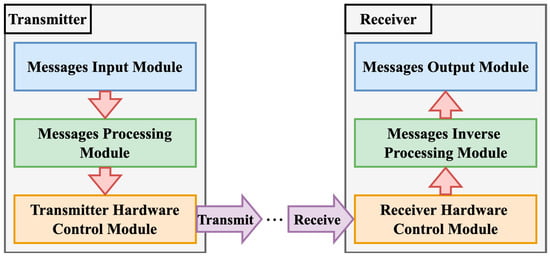
Figure 5.
The software architecture of the speech communication system.
The message input module processes the speech recognition function, recognizes the speech content, and converts it into data. The message processing module processes the transmitted messages and generates the transmitting sequence. To extend the message processing function, the data processing function can be extended by inheriting and rewriting the extension points reserved for this part. The transmitter hardware control module controls the AFG to modulate and transmit the signals based on the transmitting parameters and the transmitting sequence. The hardware control of the AFG was achieved by the NI-VISA library, and the software system packaged the control commands well. Hence, the control commands can be easily entered via the Universal Serial Bus (USB).
In communication channels, the receiver hardware control module implements signal sniffing. Upon detecting a transmission within the channel, this module receives and demodulates the signals and judges the bit value based on the reference voltage. The message inverse processing module then deciphers the received message from its binary representation, employing user-defined message processing functions such as decompression and decryption as necessary. Following that, the message output module implements the received message’s output, such as by displaying messages on the screen or broadcasting messages via voice broadcast.
3. Results
The PZT-42 mechanical antenna enables our speech communication system to achieve low-frequency communication while miniaturizing the antenna with extremely low power consumption and without the need for complex impedance matching networks. Comparing with the permanent magnet mechanical antenna, the piezoelectric antenna has a higher radiation intensity and a higher baud rate. In addition, the signal modulation of the permanent magnet mechanical antenna depends on the speed of the external drive motor, which requires high performance from the motor. In contrast, the piezoelectric mechanical antenna can flexibly realize the signal modulation by changing the feed voltage and carrier frequency. Therefore, piezoelectric antenna communication can provide better performance for the proposed system. Based on the above mechanical antenna speech communication system, an end-to-end communication process illustrated in Figure 6 is conducted as a case study to visually describe the system workflow.
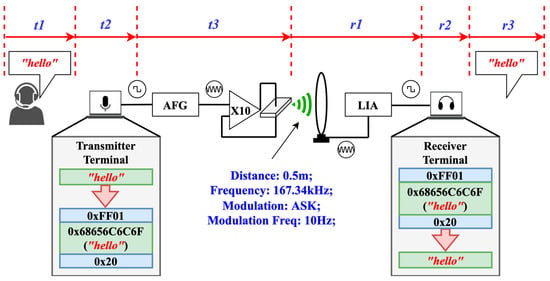
Figure 6.
A case of an end-to-end communication process.
3.1. Transmitter Side
In this case, the end-to-end communication process is divided into distinct phases, with the first three phases (t1–t3) located at the transmitter side, and the remaining three phases (r1–r3) located at the receiver side. In our measurement environment, the operating frequency was set to 167.34 kHz based on the resonant frequency of the PZT-42, and the transmission distance was set to 0.5 m. The modulation method was ASK, and the frequency of the modulation was fixed at 10 Hz in order to facilitate the observation of the measured data. With such experimental parameters, our communication system is capable of transmitting ten bits per second, which can become higher as the modulation frequency increases:
- t1 Message Input: The user says “hello” to the microphone, and the transmitter terminal recognizes the user’s speech and converts it into text;
- t2 Message Processing and Encoding: This message “hello” is processed and converted to a binary code. If the user has defined a method to process the data, the data is processed first. Otherwise, the message will be encoded directly. For example, the process of the original message “hello” without extra processing is as follows:
- Obtain the ASCII code of “hello”, expressed in hexadecimal as “0x68656C6C6F”;
- Append control information such as the frame header and frame tail to get the complete transmitting sequence: “0xFF0168656C6C6F20” in hexadecimal;
- Convert to binary code to get the final binary string to be transmitted;
- t3 Message Transmitting: As shown in Figure 7a, the binary string obtained in the previous step is used as the source signals. The transmitter terminal controls the AFG and modulates the signals. This system utilizes ASK modulation to modulate binary 1 as a sine wave at 167.34 kHz with 16,734 repeated cycles, while binary 0 is represented by the absence of any signal transmission. Figure 7b depicts the message’s final modulated signals. These signals are amplified and fed directly to the mechanical antenna, which then radiates into free space.
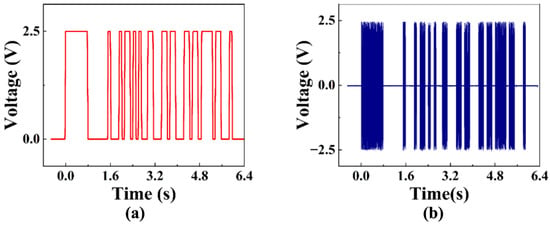 Figure 7. Measured time domain signals from the transmitter side. (a) Source signals. (b) Modulated signals.
Figure 7. Measured time domain signals from the transmitter side. (a) Source signals. (b) Modulated signals.
3.2. Receiver Side
- r1 Message Receiving: The loop antenna receives and transmits the signals to LIA. The receiving terminal continuously reads the voltage value of the frequency on the communicating channel from LIA and judges the bit value. A received signal higher than the reference voltage represents binary 1, and a received signal lower than the reference voltage represents binary 0. When a string of binary 1 is identified, the receiver terminal begins signal reception. The modulated signals received by LIA are shown in Figure 8a. As illustrated in Figure 8b, the LIA filters out the noise and demodulates the received signals to obtain the final demodulated signals. At the receiver terminal, the demodulated signals are sampled and judged according to the reference voltage, and the complete transmitting binary string is ultimately obtained;
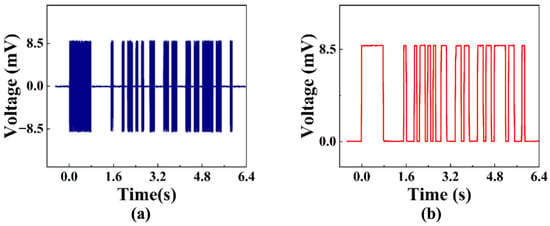 Figure 8. Measured time domain signals of receiver side. (a) Received signals. (b) Demodulated signals.
Figure 8. Measured time domain signals of receiver side. (a) Received signals. (b) Demodulated signals. - r2 Message Decoding and Inverse Processing: If the user defines additional data processing work such as encryption and compression, the corresponding inverse processing work of decryption and decompression should also be performed. Since there is no additional user-defined message processing function, the receiver terminal operates as follows:
- Decode the binary string and obtain the results: “0xFF0168656C6C6F20” in hexadecimal;
- Obtain the payload data of the message “0x68656C6C6F” located by the frame header and frame tail;
- Convert it into the original message according to ASCII encoding rules: “hello”;
- r3 Message Output: Show the received message “hello” on the receiver side.
4. Conclusions
A speech communication system based on a PZT-42 piezoelectric electret mechanical antenna was proposed. In the proposed communication system, a hardware system, a communication protocol of mechanical antennas, and a software system were reasonably designed for modularization and decoupling. Through a comprehensive examination of the system’s workflow, each component and its functions were thoroughly demonstrated, including the layered communication protocol and the software system with a modular design. It was experimentally verified that the communication system achieves real-time communication and presents a user-friendly, highly compatible, and easily expandable design as a reference for the mechanical antenna-based communication system. We will conduct additional research in the future to improve the transmission distance and bandwidth of piezoelectric electret mechanical antennas. For speech communication systems, the signal recognition algorithm will be improved to make it adaptive to changes in operating frequency and modulation frequency, and additional functions like data compression and encryption will be integrated. This speech communication system provides a promising foundation for practical applications and advances the prospects of low-frequency communication systems based on mechanical antennas.
Author Contributions
Conceptualization, J.X.; methodology, J.X.; project administration, L.G., Y.H. and J.X.; software, S.W. and P.L.; supervision, K.H. and J.X.; validation, S.W., J.Y. and S.Y.; writing—original draft, S.W.; writing—review and editing, S.W. and J.X. All authors have read and agreed to the published version of the manuscript.
Funding
This research was funded by the National Natural Science Foundation of China (Grant Nos. 52102061 and 61905021) and Teaching Reform Projects at BUPT (Grant No. 2022CXCY-B03).
Institutional Review Board Statement
Not applicable.
Informed Consent Statement
Not applicable.
Data Availability Statement
Not applicable.
Conflicts of Interest
The authors declare no conflict of interest.
References
- Idir, N.; Weens, Y.; Franchaud, J.J. Skin Effect and Dielectric Loss Models of Power Cables. IEEE Trans. Dielect. Electr. Insul. 2009, 16, 147–154. [Google Scholar] [CrossRef]
- Chowdhury, M.Z.; Shahjalal, M.; Hasan, M.K.; Jang, Y.M. The Role of Optical Wireless Communication Technologies in 5G/6G and IoT Solutions: Prospects, Directions, and Challenges. Appl. Sci. 2019, 9, 4367. [Google Scholar] [CrossRef]
- Cohen, M.B.; Inan, U.S.; Paschal, E.W. Sensitive Broadband ELF/VLF Radio Reception With the AWESOME Instrument. IEEE Trans. Geosci. Remote 2010, 48, 3–17. [Google Scholar] [CrossRef]
- García, R.M.; Novas, N.; Alcayde, A.; El Khaled, D.; Fernández-Ros, M.; Gazquez, J.A. Progress in the Knowledge, Application and Influence of Extremely Low Frequency Signals. Appl. Sci. 2020, 10, 3494. [Google Scholar] [CrossRef]
- Gussen, C.M.G.; Diniz, P.S.R.; Campos, M.L.R.; Martins, W.A.; Costa, F.M.; Gois, J.N. A Survey of Underwater Wireless Communication Technologies. J. Commun. Inf. Syst. 2016, 31, 242–255. [Google Scholar] [CrossRef]
- Hattori, K. ULF Geomagnetic Changes Associated with Large Earthquakes. Terr. Atmos. Ocean. Sci. 2004, 15, 329. [Google Scholar] [CrossRef]
- Rowe, H. Extremely Low Frequency (ELF) Communication to Submarines. IEEE Trans. Commun. 1974, 22, 371–385. [Google Scholar] [CrossRef]
- Zhima, Z.; Hu, Y.; Shen, X.; Chu, W.; Piersanti, M.; Parmentier, A.; Zhang, Z.; Wang, Q.; Huang, J.; Zhao, S.; et al. Storm-Time Features of the Ionospheric ELF/VLF Waves and Energetic Electron Fluxes Revealed by the China Seismo-Electromagnetic Satellite. Appl. Sci. 2021, 11, 2617. [Google Scholar] [CrossRef]
- Harriman, S.K.; Paschal, E.W.; Inan, U.S. Magnetic Sensor Design for Femtotesla Low-Frequency Signals. IEEE Trans. Geosci. Remote 2010, 48, 396–402. [Google Scholar] [CrossRef]
- Pfeiffer, C. Fundamental Efficiency Limits for Small Metallic Antennas. IEEE Trans. Antenn. Propag. 2017, 65, 1642–1650. [Google Scholar] [CrossRef]
- Xu, J.; Zhao, M.; Zhang, R.; Lei, M.; Gao, X.; Huang, S.; Bi, K. A Wideband F-Shaped Microstrip Antenna. Antenn. Wirel. Propag. Lett. 2017, 16, 829–832. [Google Scholar] [CrossRef]
- Chen, H.; Liang, X.; Dong, C.; He, Y.; Sun, N.; Zaeimbashi, M.; He, Y.; Gao, Y.; Parimi, P.V.; Lin, H.; et al. Ultra-Compact Mechanical Antennas. Appl. Phys. Lett. 2020, 117, 170501. [Google Scholar] [CrossRef]
- Yang, S.; Xu, J.; Guo, M.; Zhang, B.; Lan, C.; Li, H.; Bi, K. Progress on Very/Ultra Low Frequency Mechanical Antennas. ES Mater. Manuf. 2021, 16, 1–12. [Google Scholar] [CrossRef]
- Burch, H.C.; Garraud, A.; Mitchell, M.F.; Moore, R.C.; Arnold, D.P. Experimental Generation of ELF Radio Signals Using a Rotating Magnet. IEEE Trans. Antenn. Propag. 2018, 66, 6265–6272. [Google Scholar] [CrossRef]
- Fawole, O.C.; Tabib-Azar, M. An Electromechanically Modulated Permanent Magnet Antenna for Wireless Communication in Harsh Electromagnetic Environments. IEEE Trans. Antenn. Propag. 2017, 65, 6927–6936. [Google Scholar] [CrossRef]
- Guo, M.; Wen, X.; Yang, S.; Xu, J.; Pan, X.; Bi, K. Extremely-Low Frequency Mechanical Antenna Based on Vibrating Permanent Magnet. Eng. Sci. 2021, 16, 387–392. [Google Scholar] [CrossRef]
- Xu, J.; Cao, J.; Guo, M.; Yang, S.; Yao, H.; Lei, M.; Hao, Y.; Bi, K. Metamaterial Mechanical Antenna for Very Low Frequency Wireless Communication. Adv. Compos. Hybrid Mater. 2021, 4, 761–767. [Google Scholar] [CrossRef]
- Cao, J.; Yao, H.; Pang, Y.; Xu, J.; Lan, C.; Lei, M.; Bi, K. Dual-Band Piezoelectric Artificial Structure for Very Low Frequency Mechanical Antenna. Adv. Compos. Hybrid Mater. 2022, 5, 410–418. [Google Scholar] [CrossRef]
- Dong, C.; He, Y.; Li, M.; Tu, C.; Chu, Z.; Liang, X.; Chen, H.; Wei, Y.; Zaeimbashi, M.; Wang, X.; et al. A Portable Very Low Frequency (VLF) Communication System Based on Acoustically Actuated Magnetoelectric Antennas. IEEE Antenn. Wirel. Propag. 2020, 19, 398–402. [Google Scholar] [CrossRef]
- Zhou, W.; Chen, P.; Pan, Q.; Zhang, X.; Chu, B. Lead-Free Metamaterials with Enormous Apparent Piezoelectric Response. Adv. Mater. 2015, 27, 6349–6355. [Google Scholar] [CrossRef]
- Zhang, X.; Liu, J.; Chu, M.; Chu, B. Flexoelectric Piezoelectric Metamaterials Based on the Bending of Ferroelectric Ceramic Wafers. Appl. Phys. Lett. 2016, 109, 072903. [Google Scholar] [CrossRef]
- Damjanovic, D. Stress and Frequency Dependence of the Direct Piezoelectric Effect in Ferroelectric Ceramics. J. Appl. Phys. 1997, 82, 1788–1797. [Google Scholar] [CrossRef]
- Xu, Z.; Shan, X.; Chen, D.; Xie, T. A Novel Tunable Multi-Frequency Hybrid Vibration Energy Harvester Using Piezoelectric and Electromagnetic Conversion Mechanisms. Appl. Sci. 2016, 6, 10. [Google Scholar] [CrossRef]
- Xu, J.; Li, Z.; Pan, X.; Wen, X.; Cao, J.; Gong, W.; Yang, S.; Lei, M.; Yao, F.; Bi, K. Ultra-Wideband Electrostrictive Mechanical Antenna. Adv. Funct. Mater. 2022, 2210868. [Google Scholar] [CrossRef]
- Bickford, J.A.; Duwel, A.E.; Weinberg, M.S.; McNabb, R.S.; Freeman, D.K.; Ward, P.A. Performance of Electrically Small Conventional and Mechanical Antennas. IEEE Trans. Antenn. Propag. 2019, 67, 2209–2223. [Google Scholar] [CrossRef]
- Zimmermann, H. OSI Reference Model—The ISO Model of Architecture for Open Systems Interconnection. IEEE Trans. Commun. 1980, 28, 425–432. [Google Scholar] [CrossRef]
Disclaimer/Publisher’s Note: The statements, opinions and data contained in all publications are solely those of the individual author(s) and contributor(s) and not of MDPI and/or the editor(s). MDPI and/or the editor(s) disclaim responsibility for any injury to people or property resulting from any ideas, methods, instructions or products referred to in the content. |
© 2023 by the authors. Licensee MDPI, Basel, Switzerland. This article is an open access article distributed under the terms and conditions of the Creative Commons Attribution (CC BY) license (https://creativecommons.org/licenses/by/4.0/).